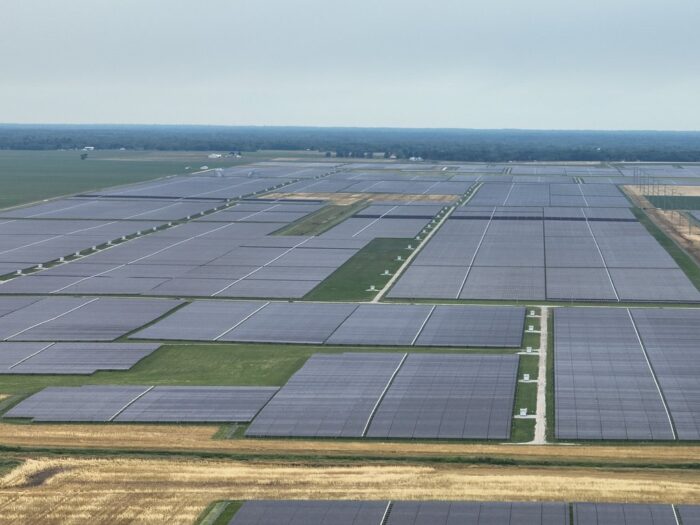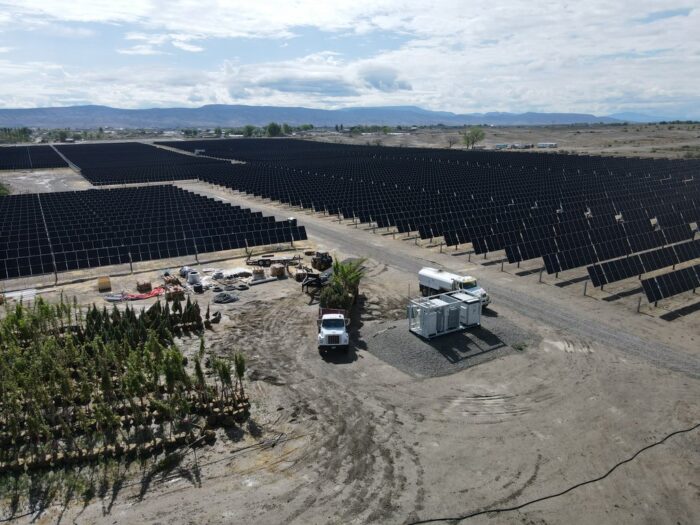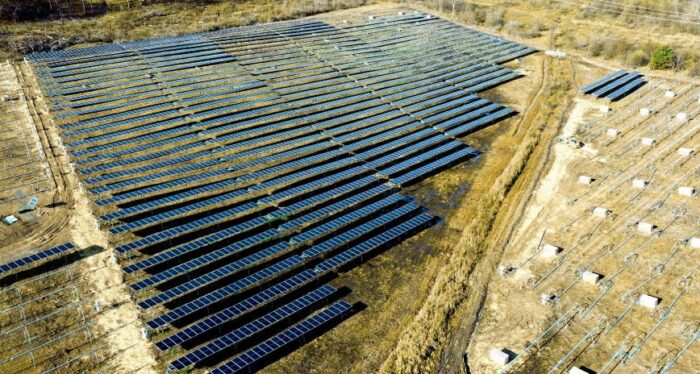Vote: Project of the Year 2025 | Over 10 MW

Here are the Over 10 MW nominees for the 2025 Solar Builder Project of the Year awards.
The form is at the bottom of the page. You are allowed to vote once per day from now until Friday, Oct. 10 at midnight (ET). (FYI: Our voting widget will let you vote more than once a day, but we filter these out in the back-end. Sorry, ballot stuffers.) Winners will be announced and prominently featured in the Q4 issue of Solar Builder magazine and online in December.
Thanks to Aurora Solar for sponsoring the 2025 Project of the Year Awards.
Be sure to vote in every category!
Double Black Diamond Solar
Virden, Illinois | 593 MW

Double Black Diamond Solar (DBD), developed by Swift Current Energy (Swift Current), is the largest operating solar facility in Illinois and east of the Mississippi River. McCarthy Building Companies, Inc. (McCarthy) served as the EPC for the 593-megawatt (MW) ac/800 MWdc solar project, finishing on time, and on budget.
Technical Merits & Installation Challenges | The project was initially designed for First Solar’s Series 6+ modules — a majority of which were domestically manufactured. However, upon the release of the new Series 7 modules, Swift Current opted to pilot the new modules for improved energy yield, lower degradation rates, and increased domestic content. Ultimately, the project employed a 50/50 mix of the two modules, requiring that McCarthy adjust its installation plan to accommodate two different installation methods using different tools. In collaboration with Swift Current, McCarthy quickly adjusted its plan by developing and implementing a retraining strategy on site and comprehensively updating all Task Hazard Analyses (THAs) to accommodate for increased risks and safety concerns caused by the module mix. The strategy and adjustments were successful and yielded a combined total of more than 1.4 million labor hours with zero lost time incidents.
Given the size of the facility, McCarthy established a phased turnover approach to enable Swift Current to generate power and revenue before the facility’s entire completion, allowing the construction team to identify and resolve technical issues on a smaller scale and better allocate labor and resources. The team initially turned over half of the facility seven months early, followed by commissioning and turnover of 50 MW portions in the month that followed.
ROI for the Community | DBD provides significant returns to the community, generating substantial tax revenue for Sangamon and Morgan counties. Through the project’s energization, Swift Current will contribute more than $10 million in community benefit funds to support the Sangamon Growth Alliance, Auburn School District, City of Chicago, and Cook County. Additionally, the project hired more than 430 local craft professionals, with many being first-time energy sector workers launching into new careers.
DBD establishes a new reliable energy source for the City of Chicago. In fact, approximately 70% of the electricity used by City-run facilities, such as major travel hubs like O’Hare and Midway airports, is sourced from DBD. Other reputable organizations including Cook County, CVS Health, Loyola University, PPG, State Farm, and TransUnion are also sourcing power from the project via Constellation NewEnergy, Inc.
Developer: Swift Current Energy | EPCs: McCarthy Building Co. | Installers: Operating Engineers Local 12, Southwest Regional Council of Carpenters, Southern California District Council of Laborers and affiliated LiUNA Local 220, Electricians of IBEW Locas 428 and 357, Operating Engineers L:ocal 12, IEW Local 47, Ironworkers of Locals 416 and 433 | Modules: First Solar | Inverters: Sungrow | Mounting/Racking: Nextracker
Eland Solar + Storage Project
758 MWdc PV + 300 MW / 1,200 MWh storage

Arevon’s megaproject is more than ten times the size of Dodger Stadium — parking lots included — and is one of the nation’s largest hybrid power plants. Eland meets 7% of Los Angeles’s electricity demand, serving more than four million residents through the Southern California Public Power Authority (SCPPA), who administers the contracts with the Los Angeles Department of Water and Power (LADWP) and Glendale Water and Power.
Achieving operations at Eland was no easy feat. In 2019, when the Eland project was initially approved, pricing for power purchase agreements (PPAs) were at record lows. During the pandemic, supply chain disruptions — specifically for inverters and panels — delayed progress for a full 18 months. These disruptions, paired with macro-economic factors, caused the cost of the project to increase significantly. Despite this, Arevon honored Eland 1’s original PPA price with SCPPA.
Eland goes beyond power production. Arevon collaborated with the Safe Haven Kid’s League of California City, a grassroots nonprofit dedicated to improving the lives of disadvantaged children and families across Southeast Kern County. The Arevon partnership supports food security, education, infant care, and job reentry for local households. Arevon also contributed to support infrastructure improvements for Balsitis Park, located in an underserved California City neighborhood. The donation helped to fund volunteer clean-up events and partnerships with educational programs to promote the importance of outdoor activities for community health and wellbeing.
Developer: Arevon | EPC/Installer: SOLV Energy and Rosendin | Modules: Jinko Solar | Inverters: Sungrow | Storage: Tesla | Trackers: Nextracker
Garnet Mesa Solar
Delta, Colorado | 102.3 MW

The Garnet Mesa Solar Project is an agrivoltaics project — promoting the dual use of land for both solar energy generation and agricultural production. It is one of the largest agrivoltaic projects in Colorado at 102.3 MWdc and will host up to 600 sheep for grazing.
A particularly rare and innovative feature of this project is its active irrigation system, which is virtually unheard of at this scale in utility solar development. The system was intentionally designed to maintain historical levels of irrigation across the site, supporting healthy pasture growth and vegetation under and around the solar panels. This promotes effective grazing practices, enhances soil health, and contributes to long-term land stewardship.
From a construction standpoint, the project required design and installation techniques to accommodate livestock movement and ensure long-term durability. Panel heights, fencing, and access routes were all customized to support dual-use functionality without compromising energy output or safety.
Some of the installation challenges that occurred include subsurface conditions and pile driving delays as well as water table and drainage issues. These conditions significantly slowed the installation of PD-10-driven piles and created challenges with site drainage and trenching. To address pile driving delays, the construction team adjusted installation techniques, optimized equipment usage, and coordinated closely with geotechnical experts to maintain progress and minimize schedule impacts. To address the water and drainage issues, the team quickly mobilized to install temporary dewatering solutions and regrade affected areas to maintain progress.
Developer: Alluvial Power | EPC/Installer: Primoris Renewable Energy | Modules: Jinko Solar | Inverters: Sungrow | Mounting/Racking: Nextracker
PureSky New York Community Portfolio
New York | 26.12 MW

PureSky Energy’s New York community solar portfolio is a powerful example of how innovation and technical precision can drive scalable, sustainable impact. Tasked with deploying over 26 MW of solar across four uniquely challenging sites, in Clover Meadow, Canandaigua, Tamarac, and Green Dale, New York, PureSky partnered with Terrasmart to overcome variable terrain, permitting delays, and challenging subsurface conditions.
The tracker system had to be designed for the rocky soils, frost zones, and uneven topography of upstate New York. Terrasmart’s ground screws eliminated the need for costly civil work, saving $300,000 in site prep, and allowed for rapid deployment in difficult terrain. A flexible design enabled layout adjustments for ponds and standing water, while its simplified wire management and lower foundation count reduced labor time by over 30%, ultimately saving $100,000+ in labor and $137,500 in materials. In total, PureSky reports savings of nearly half a million dollars in avoided man hours and materials.
Developer: PureSky Energy | EPC/Installer: Empyrean Power Services LLC | Modules: Vikram Solar | Inverters: Power Electronics and Sungrow | Mounting/Racking: Terrasmart





Comments are closed here.